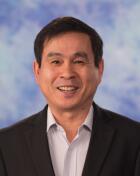Keynote Speaker----Prof. Liqiu Wang

Prof. Liqiu Wang, Department of Mechanical Engineering, the University of Hong Kong, Hong Kong, China
HKU-Zhejiang Institute of Research and Innovation (HKU-ZIRI), Zhejiang, China
Prof. L. Q. Wang received his PhD from University of Alberta and is currently a full professor in the Department of Mechanical Engineering, the University of Hong Kong. He is also the Qianren Scholar (Zhejiang) and serves as the director and the chief scientist for the Laboratory for Nanofluids and Thermal Engineering, Zhejiang Institute of Research and Innovation (HKU-ZIRI), the University of Hong Kong. He serves also as the Acting Executive Director for the HKU-ZIRI and has over 30 years of university experience in thermal & power engineering, energy & environment, transport phenomena, materials, nanotechnology, biotechnology, and applied mathematics in Canada, China/Hong Kong, Singapore and the USA, and 2 years of industrial experience as CTO & Chief Scientist in thermal engineering and technology management. Prof. Wang has secured over 70 projects funded by diverse funding agencies and industries including the Research Grants Council of Hong Kong, the National Science Foundation of China and the Ministry of Science and Technology of China, totaling > US$20m. Prof. Wang has published 10 books/monographs and over 370 book chapters and technical articles including 8 in the Nature family journals and 10 in the Physical Review Letters, many of which have been widely used by researchers all over the world, and is ranked amongst the top 1% of most-cited scientists (ESI). He has also filed 26 patent applications.
Prof. Wang's work has received recognition through a number of awards, including the most recent Innovation Award by the Optical Society presented during the 7th International Multidisciplinary Conference on Optofluidics 2017 (Singapore; 25th -28th July 2017). He was visiting professor of Harvard University (2008) and Duke University (2003). He has presented over 50 invited plenary/keynote lectures at international conferences, and serves/served as the editor-in-chief for the Advances in Transport Phenomena, the editor for the Scientific Reports, the associate editor for the Current Nanoscience, the guest editor for the Journal of Heat Transfer, the Nanoscale Research Letters and the Advances in Mechanical Engineering, and serves on the editorial boards of 20 international journals.
Speech Title: Small is Big: Bio-inspired and Microfluidics-enabled Structures for Manipulating Liquids
ABSTRACT: Nature has always been our inspiration source of innovations. Chinese Kung Fu developed effective moves from hunting skills of powerful beasts like snakes, eagles, and tigers; airplanes mimic the skillful flight of birds; legged robots imitate legged animals such as dogs and spiders. Nowadays, state-of-the-art technology enables us to unveil mysteries of the microscopic world and thus invent at microscale with precision. We have been using the precision of microfluidics in manipulating liquids at nano-, pico-, femto- and even atto-liters and engineering nano-/micro- structures to mimic evolutionarily-optimized nano/microstructures in insects that interact with liquids, and thus developed a series of techniques for manipulating liquids precisely: water collecting, liquids repelling, and droplets manoeuvring. The breakthroughs have yielded three articles in Nature Communications published in 2017.
Unique structural and topological features of spider-silks and their web enable them being a super water collector witnessed by a large number of water droplets handing on them in the early morning. With the microfluidic technology, we have precisely fabricated robust microfibers with spindle cavity-knots and different topological fiber-networks in mimicking these features. These microfibers are endowed with unique surface roughness, mechanical strength, and long-term durability, thus enabling a super performance in collecting water. The maximum water volume collected on a single knot is almost 495 times the knot volume; the water collection is even more efficient and scalable with their networks. These light-weighted yet tough, low-cost microfibers offer promising opportunities for large-scale water collection in water-deficient areas.
On a sunny summer day, beaches are full of joys: kids build sand castles; adults swim or surf waves. However, people have to suffer from getting clothes wet. Inspired by springtail cuticle, we have fabricated liquid-repellent surfaces that can eliminate this situation. The fabrication technique is based on microfluidic-droplets templates, similar to the method for making shaped cookies using baking molds. The functional surfaces repel both water and oils attributed to springtail-cuticle-mimicked nano/microstructures. The work offers deep insights of liquid-repelling structures and benefits our daily life significantly with applications in various fields ranging from clothes, kitchenware, automobiles, chemical engineering and electronics to bio-medical industry and advanced manufacturing where repelling liquid is relevant.
Some semiaquatic insects can readily walk on water and climb up menisci slope due to the dense hair mat and retractable claws of complementary wettability on their tarsi. Inspired by this, we created a mechano-regulated surface whose adhesive force to liquid droplets can be simply switched through mechanical regulation. The mechano-regulated surface functions as a “magic hand” that can capture and release multiple tiny droplets precisely in a loss-free manner, and works for both water and oil droplets down to nano-litre scale. These surfaces are relevant and crucial in various high-precision fields such as medical diagnosis and drug discovery where the precise transferring of tiny liquid is a must.
Learning from nature paves the way for creating nano/microstructures with unique features to interact with liquids on-demand. Small yet powerful, these structures can manipulate liquids of volume much larger than their dimensions effectively and precisely. With these techniques, water can be gathered directly from the air in deserts, clothes are never been wetted on rainy days, and liquids can be conveniently handled like solids.


